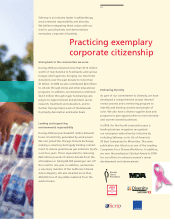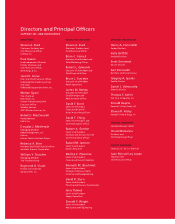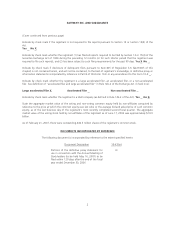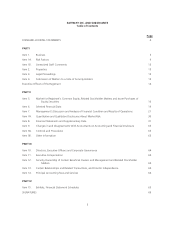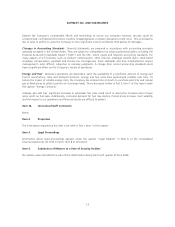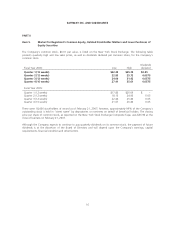Safeway 2006 Annual Report Download - page 27
Download and view the complete annual report
Please find page 27 of the 2006 Safeway annual report below. You can navigate through the pages in the report by either clicking on the pages listed below, or by using the keyword search tool below to find specific information within the annual report.SAFEWAY INC. AND SUBSIDIARIES
Compliance with Environmental Laws The Company’s compliance with the federal, state, local and foreign laws
and regulations which have been enacted or adopted regulating the discharge of materials into the environment or
otherwise related to the protection of the environment, has not had and is not expected to have a material adverse
effect upon the Company’s financial position or results of operations.
Employees At year-end 2006, Safeway had more than 207,000 full- and part-time employees. Approximately 80%
of Safeway’s employees in the United States and Canada are covered by collective bargaining agreements negotiated
with union locals affiliated with one of 10 different international unions. There are approximately 400 such
agreements, typically having three-year terms, with some agreements having terms of up to five years. Accordingly,
Safeway renegotiates a significant number of these agreements every year.
During 2006 contracts covering approximately 6,000 employees were ratified. The United Food and Commercial
Workers International Union (“UFCW”) collective bargaining agreements which covered approximately 4,700
employees, primarily in the Company’s Northern California, Denver and Seattle divisions’ stores, were ratified.
Other Labor Matters On October 11, 2003, seven UFCW locals struck the Company’s 289 stores in Southern
California. As a result, pursuant to the terms of a multi-employer bargaining arrangement, Kroger and Albertson’s
locked out certain of their retail union employees in Southern California food stores. An agreement ending the strike
was ratified by the union locals on February 28, 2004. Employees returned to work beginning March 5, 2004. Safeway
estimates the overall cost of the strike and its residual effects reduced 2004 earnings by $412.2 million before taxes
($0.57 per diluted share). Safeway estimated the impact of the strike by comparing internal forecasts immediately
before the strike with actual results during and after the strike, at strike-affected stores. The estimate also includes the
Company’s benefit under an agreement with Kroger and Albertson’s that arose out of the multi-employer bargaining
process in Southern California.
Financial Information about Geographic Areas Note L to the consolidated financial statements set forth in Part II,
Item 8 of this report provides financial information by geographic area.
Available Information Safeway’s corporate Web site is located at www.safeway.com. You may access our
Securities and Exchange Commission (“SEC”) filings free of charge at our corporate Web site promptly after such
material is electronically filed with, or furnished to, the SEC. We also maintain certain corporate governance
documents on our Web site, including the Company’s Corporate Governance Guidelines, our Director Independence
Standards, the Code of Business Conduct and Ethics for the Company’s corporate directors, officers and employees,
and the charters for our Audit, Nominating and Corporate Governance, and Executive Compensation committees. We
will provide a copy of any such documents to any stockholder who requests it. We do not intend for information
found on the Company’s Web site to be part of this document.
Item 1A. Risk Factors
We wish to caution you that there are risks and uncertainties that could affect our business. These risks and
uncertainties include, but are not limited to, the risks described below and elsewhere in this report, particularly in
“Forward-Looking Statements.” The following is not intended to be a complete discussion of all potential risks or
uncertainties, as it is not possible to predict or identify all risk factors.
Competitive Industry Conditions We face intense competition from traditional grocery retailers, non-traditional
competitors such as supercenters and club stores, as well as from specialty supermarkets, drug stores, dollar stores,
convenience stores and restaurants. Increased competition may have an adverse effect on profitability as the result of
lower sales, lower gross profits and/or greater operating costs such as marketing.
Our ability to attract customers is dependent, in large part, upon a combination of price, quality, product mix, brand
recognition, store location, in-store marketing and design, promotional strategies and continued growth into new
markets. In each of these areas, traditional and non-traditional competitors compete with us and may successfully
9


